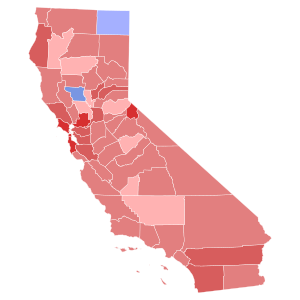
Hiram Warren Johnson was an American attorney and politician who served as the 23rd governor of California from 1911 to 1917. Johnson achieved national prominence in the early 20th century. He was elected in 1916 as the United States Senator from California, where he was re-elected to five terms and served until his death in 1945.
A write-in candidate is a candidate whose name does not appear on the ballot but seeks election by asking voters to cast a vote for the candidate by physically writing in the person's name on the ballot. Depending on electoral law it may be possible to win an election by winning a sufficient number of such write-in votes, which count equally as if the person were formally listed on the ballot.

The 1968 United States Senate elections were elections for the United States Senate. Held on November 5, the 34 seats of Class 3 were contested in regular elections. They coincided with the presidential election of the same year. The Republicans picked up five net seats in the Senate. This saw Republicans win a Senate seat in Florida for the first time since Reconstruction.

The 1954 United States Senate elections was a midterm election in the first term of Dwight D. Eisenhower's presidency. The 32 Senate seats of Class 2 were contested in regular elections, and six special elections were held to fill vacancies. Eisenhower's Republican party lost a net of two seats to the Democratic opposition. This small change was just enough to give Democrats control of the chamber with the support of an Independent who agreed to caucus with them, he later officially joined the party in April 1955.

The 1916 United States Senate elections were elections that coincided with the re-election of President Woodrow Wilson. This was the first election since the enactment of the Seventeenth Amendment that all 32 Class 1 Senators were selected by direct or popular elections instead of state legislatures. Republicans gained a net of two seats from the Democrats, and then a furthered seat through mid-term vacancies thereby reducing Democrats to a 53-43 majority.
This is a list detailing the electoral history of the Libertarian Party in the United States, sorted by office. The list currently consists of candidates who ran for partisan office.
George H. McLain was a United States Democratic politician from California and an influential pension promoter from the 1930s through the early 1950s.
Richard Nixon served as the 37th president of the United States from 1969 to 1974. He previously served as the 36th vice president of the United States from 1953 to 1961, and as a United States senator from 1950 to 1953 and United States representative from 1947 to 1950.

Electoral history of Lyndon B. Johnson, who served as the 36th president of the United States (1963–1969), the 37th vice president (1961–1963); and as a United States senator (1949–1961) and United States representative (1937–1949) from Texas.

Electoral history of William Edgar Borah, United States Senator from Idaho (1907–1940)

George Smith Patton was an American attorney, businessman and politician who served as Los Angeles County District Attorney and the first mayor of San Marino, California.

Roque "Rocky" De La Fuente Guerra is an American businessman and politician. A perennial candidate, De La Fuente was the Reform Party nominee in the 2016 and 2020 United States presidential elections. He also appeared on his own American Delta Party's presidential ticket in 2016, and on those of the Alliance Party and American Independent Party in 2020.

The 1938 United States Senate election in California was held on November 2, 1938. Incumbent Democratic Senator William Gibbs McAdoo ran for a second term, but was defeated by Sheridan Downey in the Democratic primary. Downey went on to defeat Philip Bancroft in the general election.

Two 2022 United States Senate elections in California were held concurrently on November 8, 2022, to elect a member of the United States Senate to represent the State of California. There were two ballot items for the same Class 3 seat: a special election to fill the seat for the final weeks of the 117th United States Congress, and a general election for a full term, starting in the 118th United States Congress.

The 1922 United States Senate election in California was held on November 7, 1922. Incumbent Republican Senator Hiram Johnson was re-elected to his second term in office.

The 1928 United States Senate election in California was held on November 6, 1928. Incumbent Republican Senator Hiram Johnson was re-elected to his third term in office. He defeated Democrat Minor Moore and Prohibition Party nominee Los Angeles City Councilman Charles H. Randall.

The 1934 United States Senate election in California was held on November 6, 1934. Incumbent Republican Senator Hiram Johnson was re-elected to his fourth term in office.

The United States Senate election in California of 1940 was held on November 5, 1940. Incumbent Republican Senator Hiram Johnson was re-elected to his fifth term in office, though he would die in office in 1945.

The two 1946 United States Senate elections in California were held concurrently on November 5, 1946.

The 2020 South Carolina State Senate elections took place as part of the biennial 2020 United States elections. South Carolina voters elected state senators in all 46 senate districts. State senators serve four-year terms in the South Carolina Senate, with all of the seats up for election each cycle. The primary elections on June 9, 2020, determined which candidates appeared on the November 3, 2020, general election ballot.




















